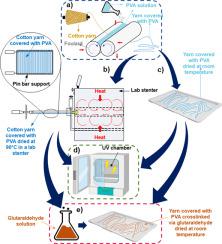Progress in Organic Coatings ( IF 6.6 ) Pub Date : 2021-07-20 , DOI: 10.1016/j.porgcoat.2021.106397 Ana Paula S. Immich 1 , Pedro H. Hermes de Araújo 1 , Luiz Henrique Catalani 2 , Selene M.A.G.U. Souza 1 , Carlos Rafael Oliveria 3 , Antônio Augusto U. Souza 1

|
In the textile industry, the coating or sizing of cotton yarn aims to increase its tensile strength during weaving processes. The choice of sizing formulation is strategic to provide maximum process performance. Therefore, the objective of this investigation is to study the coating of cotton yarn using poly(vinyl alcohol), aiming to provide temporary tensile strength to it. To increase the tensile strength of the coating layer, crosslinking processes, such as via UV-C radiation and glutaraldehyde were studied. The influence of the coating process on the resistance of the yarn was measured by tensile tests. Different operational conditions were tested, such as molecular weight and polymer concentration, drying temperature of the yarns, crosslinking time, and glutaraldehyde concentration. Characterization analyzes, such as DSC, and SEM were carried out to better understand the results, which were all processed statistically. According to the results, the crosslinking of the yarns with glutaraldehyde caused a considerable reduction in polymer crystallinity, affecting the performance and stability of the yarn, impairing its mechanical properties. However, coating with PVA and crosslinking via UV-C radiation, increased the tensile strength of the yarn by up to 56% when compared to raw yarn, due to the creation of a new crystalline network reinforced by the bonds of crosslinking. The application of UV-C radiation proved to be promising since it eliminates the use of chemical reagents, avoiding the generation of toxic waste at the end of the process.
中文翻译:

通过聚合物涂层和交联获得棉纱的临时拉伸强度
在纺织工业中,棉纱的涂层或上浆旨在提高其在织造过程中的抗拉强度。施胶配方的选择对于提供最大工艺性能具有战略意义。因此,本研究的目的是研究使用聚乙烯醇的棉纱涂层,旨在为其提供临时拉伸强度。为了增加涂层的拉伸强度,研究了交联过程,例如通过 UV-C 辐射和戊二醛。通过拉伸试验测量涂层工艺对纱线电阻的影响。测试了不同的操作条件,例如分子量和聚合物浓度、纱线的干燥温度、交联时间和戊二醛浓度。表征分析,例如 DSC、并进行SEM以更好地理解结果,这些结果均进行了统计处理。结果表明,纱线与戊二醛的交联导致聚合物结晶度显着降低,影响纱线的性能和稳定性,损害其机械性能。然而,与原纱相比,用 PVA 涂层和通过 UV-C 辐射交联可将纱线的拉伸强度提高多达 56%,这是由于通过交联键增强了新的结晶网络的产生。UV-C 辐射的应用被证明是有前途的,因为它消除了化学试剂的使用,避免了在过程结束时产生有毒废物。纱线与戊二醛的交联导致聚合物结晶度显着降低,影响纱线的性能和稳定性,损害其机械性能。然而,与原纱相比,用 PVA 涂层和通过 UV-C 辐射交联可将纱线的拉伸强度提高多达 56%,这是由于交联键增强了新的结晶网络。UV-C 辐射的应用被证明是有前途的,因为它消除了化学试剂的使用,避免了在过程结束时产生有毒废物。纱线与戊二醛的交联导致聚合物结晶度显着降低,影响纱线的性能和稳定性,损害其机械性能。然而,与原纱相比,用 PVA 涂层和通过 UV-C 辐射交联可将纱线的拉伸强度提高多达 56%,这是由于交联键增强了新的结晶网络。UV-C 辐射的应用被证明是有前途的,因为它消除了化学试剂的使用,避免了在过程结束时产生有毒废物。由于通过交联键增强了新的结晶网络的产生,与原纱相比,纱线的拉伸强度提高了 56%。UV-C 辐射的应用被证明是有前途的,因为它消除了化学试剂的使用,避免了在过程结束时产生有毒废物。由于通过交联键增强了新的结晶网络的产生,与原纱相比,纱线的拉伸强度提高了 56%。UV-C 辐射的应用被证明是有前途的,因为它消除了化学试剂的使用,避免了在过程结束时产生有毒废物。


























 京公网安备 11010802027423号
京公网安备 11010802027423号